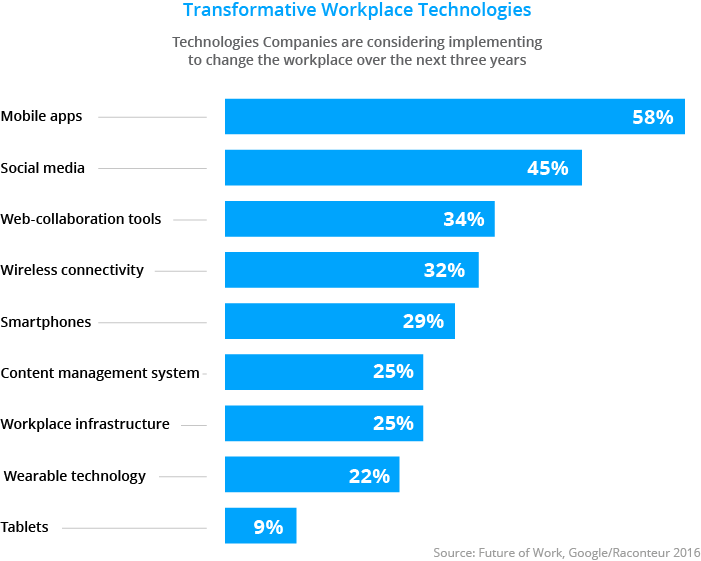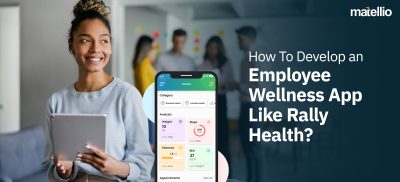
In many organizations, employee engagement is the top priority for many professionals. But at times, it’s challenging to achieve- especially when the newest generation enters the workforce.
While millennials comprise the largest generation of the workers, only 29% are engaged at work, and 71% of the workers are not working or are actively disengaged (Gallup-2016). Now, this a massive problem for businesses and organizations.
So, how can the organizations seamlessly and cost-effectively implement technology that can keep millennials engaged? Look no further than what’s in their hand or pockets every now and then-their mobile device.
Let’s know what exactly employee engagement is?
What do you think about what it is? Well, you believe that keeping the employees happy and satisfied and offering them benefits like game rooms, bean bags, Friday nights, etc. is enough? But lemme tell you, employees engagement is much more than that.
As Forbes said-
“Employee engagement is the emotional commitment, which the employee has with the organization and its goal. This emotional commitment means employees care about their work and their businesses. They don’t work just for a paycheck and just for the next promotion, but work on behalf of the organization’s goals.”
The employee’s engagement is not only about keeping the employees happy; it is about making sure that they are giving their best to the businesses in terms of productivity.
To fulfil the needs of the employees, especially the new-age employees, the organizations are deploying several technologies, to boost the employee’s engagement activities and mobile apps top that list:
Some educational workplace technologies are:
The technologies some businesses are considering implementing to change the workplace over the next three years:

Image: Source
Let’s take a tour of the area where the mobile apps can be beneficial to speed up the employee’s engagement:
1: Peer to Peer Communication:
Millennials expect their work environment to be friendly, supporting, and where communication is accessible as well as informal. Nowadays, employees have smartphones with them all the time whenever they want. According to Adobe research, around 81% agrees that technology that helps them to connect with the colleagues and other staff members effectively to their ideal to their workspace. The app can make communication amongst employees easier which ultimately makes their work easier and allows them to respond at the earliest.
2: Payroll:
Through mobile, the employees can view their pay on their own time whenever they want. Payslips are accessible; they can even raise concerns/queries, etc. It makes their lives more convenient as it saves their time like running to the finance department now and then, they need access to their payslips or need any clarifications on salary is frustrating and time-consuming as well.
3: HR operations:
While most of the businesses are using SaaS solutions or their sites for managing things like filling timesheets, raising requests, leave applications, etc. most of this information can be accessed on their Desktops, PCs, etc. These processes can make the life of the employee’s life way easier if available on a mobile app. This also provides the flexibility to fill in the timesheet, and they can apply for the leaves according to their convenience. These HR processes are typically housed in disparate systems all across the enterprise. If these processes are simplified, HR leaders can minimize friction in their working lives.
4: Internal communications:
People not just want to have a job; they want to be valued and want to feel connected with their workplace. According to a survey, “millennials rate-” being assessed as one of the crucial aspects, in an organization. The involvement of employees in the more significant decisions of the businesses, communicating with them continuously can help you keep the workforce engaged. More often than not, this crucial aspect has been left to newsletters and e-mails sent to the employees with no personal touch. Despite the fact, most of the internal communication emails happen on desktops and PCs, through official emails.
Whereas, the mobile apps can speed up internal communication efforts of an organization. Push notifications to alert the employees about the event, news and important dates, ensures higher engagement. And by delivering, time-sensitive materials, employees can quickly digitally sign and acknowledge receipt of policies in support of corporate governances. And also, a smartphone is more personal than a desktop, and the HR can leverage mobility to get live employee input.
5: Interactive learning modules:
Deloitte did the research showed, employees, falls under 25 years of age category, rate professional development as their number one component of engagement, and this the second priority of the workers up to the age of 35. Providing interactive learning modules as well as the solutions helps the enterprises fulfil their needs.
The mobile applications also facilitate learning which enables the employees to grow and to learn according to their convenience. Further, an app also provides interactive learning. In other words, the employees can retain more information through interactive modules as compared to a book or an article you give them to read.
Here are the examples of mobile apps, that are changing the game of employee engagement-
1: Microsoft Lync:
Microsoft Lync offers unified communication platforms, blending video, phone, instant messaging and work environment into a single space. The app helps in-
- Viewing colleagues availability into real-time and choose the best way to communicate-initiating instant messaging (IM), e-mail or phone calls.
- Connects you to a conference call with the single tap functionality. And doesn’t require any long passcodes or conference numbers.
- Forward or simultaneously ring calls to enterprise voice (Lync ID) number which helps users to attend every call.
2: Slack app:
The slack app is like facebook for the employees’ workplace. The slack app is both a desktop and a smartphone internal team communication and engagement tool. This helps teams consolidate their communications to a single platform. Herein, the employees are a part of the “channel” which can be both open and private. Providing one more quality of tagging people, private text them and can attach files as well. They can also look for the archive on this app to see what messages were sent.
3: Engagedly:
Engagedly built-in gamification is an employee engagement platform built for employee social collaboration, pulse survey tool, idea generation as well as employee rewards. The app enables 360-degree feedback also integrates performance management, goal setting and eLearning as well. The app takes a comprehensive and employee-driven approach to talent management.
4: Developing a Roadmap:
Some organizations and enterprises have their work structure, culture and environment. According to the needs but for some organizations, the ready-to-use software and apps are sufficed. But some organizations and businesses with urgent needs and many departments and locations might require custom software or app for employee engagement needs and requirements.
Also Read- B2B Mobile App Development: A Complete Guide
Let’s see how enterprises can start their journey for employee engagement-
Decide whether to have a custom app or an available suite of software-
Many times, Organizations tend to skew towards readily available SaaS tools. Moreover, it is believed that it is beneficial to chart out organizations needs and requirements, thoroughly and then make a decision, as to whether a custom solution or a ready-made product in the market, what would better suit your enterprise.
1: Voluntary vs Mandatory:
If any engagement is forced, then that’s not the engagement anymore. However, it also depends on the sort of tool the enterprise is deploying. It can be voluntary or optional as well. For instance, the app for internal communications or learning modules can be made optional. But one for team interaction can be mandatory.
2: Selecting Native v/s Web App:
You see Native apps are a better employee engagement solution for many reasons; for instance: app store deployability, the end-user experience, and ability to facilitate push notifications. Web apps are websites that are accessed via mobile browsers. The enterprises will have to be very careful while selecting any one between the two as it is about their budget and requirements.
3: Deciding on the first Use Cases:
The objective of developing engagement apps in any organization is to create additional value for the employees. Therefore, the first use cases you roll out are very crucial. To make sure high onboarding numbers, it is essential to launch the app with the right use-cases.
4: Deciding on the Content:
A lot of information and details can be shared on the company’s intranet or microsite. However, it is very crucial to keep the information to what is relevant. Reasons to carefully choose the contents that should go on the app are the storage space and the user experience. The modern intranet is coming up with some advanced features, including the use cases. Whereas smartphones always require a new approach to content and functionality. When we think about your app, remember that it shouldn’t be a dumping ground for old intranet.
5: Ensure robust security measures:
The mobile app provides flexibility and convenience to the employees and other staff members, as they can access the company’s information anywhere and anytime. It is very crucial to ensure security guidelines; it helps you to ensure that the critical and sensitive information of the enterprise isn’t leaked outside.
Therefore, the enterprises have to think about the app security inside and outside the app. any app sofTo do that it is advisable to limit the sensitive and crucial information you out online about the enterprise.
6: Align with the intranet roadmap:
An employee can be viewed as a channel displaying the intranet or an addition to the intranet. You have to decide if the content needs to be shared between the two platforms or not. Whereas, if you have a CMS solution, this could be ideal for you in such cases. Though, CMS systems help in customizing and distributing information of the enterprise that is highly confidential and is directly relevant to the employees. This way, the content can be safely sent to the intranet and the app.
7: Devise a rollout Strategy:
When we talk about a launch, the question arises here is whether to roll out things with a bang or should we take a soft start. However, the soft launch is advisable as shown by the experience.
It helps you to build the app from the ground up with the input of your employees. Launching the app softly avoids the danger of starting the much-anticipated project they don’t prefer and forcefully include in the process.
In conclusion:
The key to the success of any enterprise depends on its foresightedness, technology, innovation as well on the advancement. However, using three pillars are very crucial to connect with the customers, the market and the employees in the company. And to do the same, organizations should come out of their comfort zone, to design the rolls for a purpose-driven millennial workforce. The smooth internal communication is the future of the workplace, and mobile applications are enabling the change, and this would pay the way for the exciting and engaging work environment.



